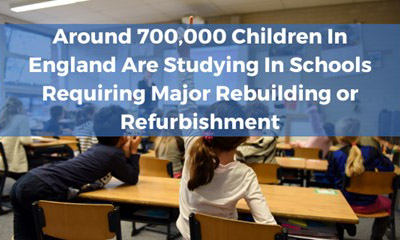According to today’s National Audit Office report on the condition of school buildings, around 700,000 children in England are attending schools that are in need of major repairs due to years of underfunding. The poor conditions in these schools directly affect pupil attainment and teacher retention.
The report also found that around 24,000 school buildings (38 per cent of the total) are currently beyond their estimated design lifespan. One major cause of concern is the prevalence of reinforced autoclaved aerated concrete (RAAC). This material is prone to failure and was regularly used between the 1950s and mid-1990s.
Property and construction expert Thomas Goodman at MyJobQuote.co.uk explains, "Reinforced Autoclaved Aerated Concrete is an aerated lightweight material without coarse aggregate. The properties and structural behaviours of this material differ significantly when compared to traditional reinforced concrete." There are many buildings, including schools, that still exist and are made using RAAC. Goodman adds, "The vast majority of structures that exist today with RAAC have the material prevalent in the roof structure, which is usually flat and difficult to inspect, maintain, and replace."
The Department for Education has been looking into the potential risks of RAAC since a recent roof collapse at a school in Kent. The incident, which happened in July 2018, affected the ceiling above the staff room and also affected other areas of the school, including ICT equipment, toilets, and administration areas. Luckily, the incident occurred on Saturday evening, and the building was empty at the time.
However, this particular incident was a wake-up call, highlighting the importance of refurbishing and renovating older buildings and the importance of inspecting schools regularly for signs of structural problems. Many schools in England still stand with RAAC materials, and the potential structural problems are unknown.
By May this year, 572 schools had been confirmed as potentially containing RAAC. The Department of Education is working with these schools to confirm the steps needed to mitigate the safety of pupils and staff.
What Is the Government Doing to Keep School Buildings Safe?
According to the government’s website, £15 billion has been spent on keeping schools safe since 2015, with a further £1.8 billion committed for 2023-24.
The government has also confirmed that it is working on identifying and rectifying schools that may have RAAC in their structural elements. There have been over 200 assessments so far of schools where RAAC is suspected. These assessments aim to identify and verify the presence of the material as well as assess the condition. The government has also confirmed that they are on track to complete 600 assessments by Autumn. RAAC has been identified in 65 schools so far, with 24 of them requiring immediate action.
In its submission for the 2020 Spending Review, the department stated that it needed £5.3 billion per year of capital funding for maintaining schools and mitigating any serious risks. Due to the length of time that it would take the department to expand the school rebuilding programme, it requested an average of £4 billion per year between 2021 and 2025. However, the Treasury has allocated an average of £3.1 billion, leading to bodies such as local authorities and academy trusts using limited funding on the most urgent issues.
Who is Responsible for Maintaining School Buildings?
According to the government’s website, it is the responsibility of the people who run the schools to maintain school buildings. These are typically academy trusts, local authorities, and voluntary-aided school bodies. These groups are responsible for alerting the government whenever there is some kind of serious concern with a building that they can’t manage. However, it is then down to the government to sort these issues, which may take time. Plus, it can be difficult for school bodies to identify structural issues without the relevant surveys needed.
The government has funding available where structural concerns are considered safety issues. However, this still means that children are spending time in school every day with potential structural issues. Some structural issues may not be visible until it's too late, which is a real cause of concern.
Unfortunately, it can be challenging for the government to understand and oversee safety issues in schools due to the size and complexity of the school estate.


